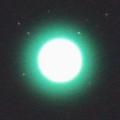
|
Great outburst occured on Oct. 24, and it bacame a naked eye comet of 2 mag. It still keeps so bright as 3.0 mag on Dec. 1. It was completely stellar just after the outburst, however, then a round disk like coma is getting larger gradually. The coma diameter has increased up to about 45 arcmin, and the comet has bacome very diffuse. So it looks like a huge faint nebula now. This comet was also in great outburst at the discovery in 1892 and became so bright as 4 mag. At that time, the comet faded after the first outburst, but soon brightened again in the second outburst. The further brightness is uncertain. But the comet will be observable in excellent condition for a while after this.
Date(TT) R.A. (2000) Decl. Delta r Elong. m1 Best Time(A, h)
Dec. 1 3 11.46 48 57.1 1.692 2.587 148 3.6 22:31 (180, 6)
Dec. 8 3 5.54 47 57.7 1.738 2.616 146 3.9 21:58 (180, 7)
|
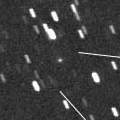
|
It will reach to 6 mag in January, and will be observable in good condition. Now it is brightening very rapidly. It is already bright as 9.3 mag (Dec. 1, Maik Meyer), large bright diffuse object visually. In the Northern Hemisphere, it keeps observable all night until mid December, then keeps observable until early February, when it fades down to 7.5 mag. In the Southern Hemisphere, it is not observable until late December. But after that, it keeps observable until it fades out.
Date(TT) R.A. (2000) Decl. Delta r Elong. m1 Best Time(A, h)
Dec. 1 20 48.66 83 44.4 0.631 1.333 108 9.5 20:41 (173,-32)
Dec. 8 22 40.57 80 19.2 0.519 1.272 111 8.7 20:49 (172,-28)
|
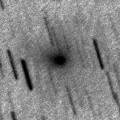
|
Now it is 10.6 mag (Oct. 14, Mike Linnolt). It is already unobservable in the Northern Hemisphere. In the Southern Hemisphere, it is not observable now for one month after mid November, but it will be observable in good condition at 10 mag from mid December to February. In the Northern Hemisphere, it will appear in the evening sky at 11 mag in March, then it keeps observable while fading gradually until May.
Date(TT) R.A. (2000) Decl. Delta r Elong. m1 Best Time(A, h)
Dec. 1 17 6.16 -39 27.0 1.860 0.989 19 9.8 20:41 ( 40, 1)
Dec. 8 17 5.58 -43 6.0 1.831 0.972 20 9.7 20:49 ( 32, -1)
|
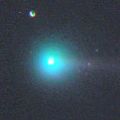
|
Already unobservable in the Northern Hemisphere, but it is observable in the evening low sky in the Southern Hemisphere. It approached down to 0.4 A.U. to the sun on Oct. 28, and it reached to 5.3 mag (Oct. 25, Juan Jose Gonzalez). Now it is fading. It has already faded down to 10.1 mag (Dec. 1, Marco Goiato). The brightening became very slow just before the perihelion passage, but it started fading rapidly after the perihelion passage. It will never be observable again in the Northern Hemisphere. But in the Southern Hemisphere, it keeps observable while fading gradually, although it will not locate very high.
Date(TT) R.A. (2000) Decl. Delta r Elong. m1 Best Time(A, h)
Dec. 1 17 33.73 -53 13.5 1.534 0.905 34 10.5 20:41 ( 33, 14)
Dec. 8 17 44.04 -55 52.2 1.689 1.037 34 11.3 20:49 ( 29, 13)
|
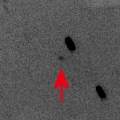
|
Brightening rapidly. Now it is 11.7 mag (Nov. 27, Juan Jose Gonzalez), already bright visually. It will reach to 8.5 mag from January to March, and will be observable in good condition. In the Northern Hemisphere, it keeps observable in good condition until 2008 July when it becomes fainter than 18 mag.
Date(TT) R.A. (2000) Decl. Delta r Elong. m1 Best Time(A, h)
Dec. 1 22 24.87 -24 17.7 1.082 1.345 80 12.4 20:41 ( 94, 51)
Dec. 8 22 37.73 -21 59.0 1.075 1.293 77 12.0 20:49 ( 93, 45)
|

|
Now it is bright as 13.0 mag and visible visually (Nov. 15, Alan Hale), brightening well as expected. It will reach to 11 mag in 2008 spring. It will keep bright for a long time, however, it keeps moving in the southern sky for a while after this. In the Northern Hemisphere, it will appear at 13 mag from October to December in a short time, but very low and hard to observe. However, it will be visible visually at 11 mag in the evening sky from March to June in 2008. Then it becomes unobservable again. But it will appear in the morning sky again at 13 mag at the end of 2008, then it keeps bright and observable for a while.
Date(TT) R.A. (2000) Decl. Delta r Elong. m1 Best Time(A, h)
Dec. 1 9 39.71 -45 15.3 3.512 3.521 82 13.0 2:56 (303, 64)
Dec. 8 9 44.23 -46 27.0 3.419 3.480 85 12.9 2:53 (308, 67)
|

|
It has already brightened up to 14.7 mag and has been already visible visually (Nov. 18, Alan Hale). It will pass very near by the Earth in early December, and reach to 13 mag. It is observable in good condition in the morning sky, and will be easy to see visually. However, it turns to fade out and move lower very rapidly after Dec. 10, and it will be unobservable within a few days. Then it will never be observable again. It locates somewhat low in the Southern Hemisphere.
Date(TT) R.A. (2000) Decl. Delta r Elong. m1 Best Time(A, h)
Dec. 1 9 41.94 25 17.7 0.231 1.082 108 13.4 2:56 (211, 22)
Dec. 8 12 2.11 8 9.4 0.130 0.967 78 13.1 2:53 (244, 19)
|

|
Now it is faint as 13.9 mag (Nov. 29, Katsumi Yoshimoto). It has been observable since late July, but it keeps faint in this season. It has never be brighter than 14 mag yet.
Date(TT) R.A. (2000) Decl. Delta r Elong. m1 Best Time(A, h)
Dec. 1 6 21.09 30 50.0 5.078 5.971 152 13.3 1:45 (180, 24)
Dec. 8 6 17.68 30 51.1 5.038 5.974 160 13.3 1:14 (180, 24)
|
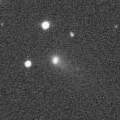
|
Now it is bright and visible visually at 13.6 mag (Nov. 3, Seiichi Yoshida). It is observable at 13.5 mag in good condition from autumn to winter.
Date(TT) R.A. (2000) Decl. Delta r Elong. m1 Best Time(A, h)
Dec. 1 0 32.37 26 13.0 0.929 1.713 126 13.4 20:41 (168, 28)
Dec. 8 0 39.42 26 36.0 0.967 1.707 122 13.4 20:49 (161, 26)
|
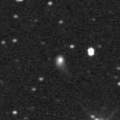
|
It is already bright and visible visually at 13.9 mag (Nov. 3, Seiichi Yoshida). It will reach to 10.5 mag and will be observable in good condition in 2008 autumn. It keeps observable in good condition for a long time while the comet is getting brighter slowly.
Date(TT) R.A. (2000) Decl. Delta r Elong. m1 Best Time(A, h)
Dec. 1 21 24.29 -5 11.5 4.050 3.890 73 13.9 20:41 (104, 28)
Dec. 8 21 28.63 -4 36.3 4.097 3.838 67 13.9 20:49 (100, 21)
|
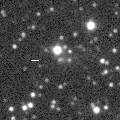
|
Now it is 14.2 mag (Nov. 4, Alan Hale), already visible visually. It will reach to 14 mag in winter, and will be observable in good condition. It keeps observable in good condition for a long time until 2008 spring.
Date(TT) R.A. (2000) Decl. Delta r Elong. m1 Best Time(A, h)
Dec. 1 7 57.43 20 53.1 1.877 2.632 131 14.1 2:56 (187, 34)
Dec. 8 7 58.67 20 14.6 1.817 2.630 137 14.0 2:53 (180, 35)
|
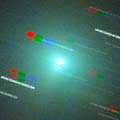
|
It reached to 7.2 mag on July 14 (Maik Meyer), then it faded down to 9.0 mag on Aug. 13 (Carlos Labordena). Although it had been unobservable for a while, now it is observable again. In the Southern Hemisphere, it keeps observable while fading gradually. In the Northern Hemisphere, it will be fading while keeping extremely low.
Date(TT) R.A. (2000) Decl. Delta r Elong. m1 Best Time(A, h)
Dec. 1 11 48.88 -41 2.7 2.323 2.030 60 14.1 2:56 (297, 40)
Dec. 8 11 37.47 -43 5.2 2.286 2.115 67 14.3 2:53 (298, 47)
|
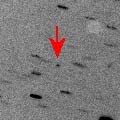
|
It brightened very rapidly in a short time, and now it reached to 15.3 mag (Nov. 3, Tony Farkas). It will be observable at 14.5-15 mag in an excellent condition from October to February. It may be visible visually, but it was not visible, fainter than 14.4 mag, on Oct. 5 (Seiichi Yoshida).
Date(TT) R.A. (2000) Decl. Delta r Elong. m1 Best Time(A, h)
Dec. 1 5 30.18 32 50.3 1.563 2.519 161 14.6 0:54 (180, 22)
Dec. 8 5 24.22 32 18.8 1.540 2.513 168 14.6 0:20 (180, 23)
|
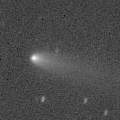
|
It reached up to 12.6 mag and was bright visually in autumn (Oct. 5, Seiichi Yoshida). Now it is fading, but it is still bright and visible visually at 13.3 mag (Nov. 3, Seiichi Yoshida). It keeps observable in good condition for a while after this. It will be visible visually for some more time.
Date(TT) R.A. (2000) Decl. Delta r Elong. m1 Best Time(A, h)
Dec. 1 0 10.78 -12 35.4 1.890 2.395 108 14.7 20:41 (141, 62)
Dec. 8 0 16.20 -11 43.9 1.985 2.410 103 14.8 20:49 (130, 57)
|
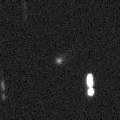
|
Now it is 15.9 mag (Sept. 8, Ken-ichi Kadota), brightening as expected. It will reach to 13.5 mag in the southern sky in 2008 spring and summer. In the Southern Hemisphere, it keeps observable for a long time after this. But in the Northern Hemisphere, it keeps locating extremely low until January, and will be unobservable after that. Then it will be observable again at the end of 2008, when the comet will already fade down to 15 mag.
Date(TT) R.A. (2000) Decl. Delta r Elong. m1 Best Time(A, h)
Dec. 1 0 18.63 -46 55.6 3.010 3.194 91 14.9 20:41 ( 40, 73)
Dec. 8 0 16.41 -47 9.0 3.060 3.150 86 14.9 20:49 ( 49, 68)
|
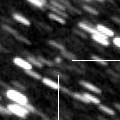
|
Now it is 15.8 mag (Sept. 2, R. Salvo). It keeps 15 mag for a long time until 2008 spring. It moves in the southen sky, so it keeps observable in good condition in the Southern Hemisphere, although it becomes low only in winter. It will never be observable again in the Northern Hemisphere.
Date(TT) R.A. (2000) Decl. Delta r Elong. m1 Best Time(A, h)
Dec. 1 17 14.26 -61 32.8 3.871 3.189 40 15.0 20:41 ( 25, 18)
Dec. 8 17 21.18 -62 30.1 3.880 3.190 40 15.0 20:49 ( 22, 16)
|
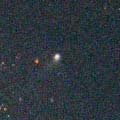
|
It was visible visually at 14 mag from spring to autumn in 2007. Now it is not observable. But it will be observable at 14 mag at high location again in 2008 spring.
Date(TT) R.A. (2000) Decl. Delta r Elong. m1 Best Time(A, h)
Dec. 1 16 57.81 -0 23.4 6.501 5.604 22 15.2 20:41 ( 67,-28)
Dec. 8 17 0.10 -0 7.6 6.499 5.602 22 15.1 20:49 ( 61,-35)
|
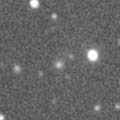
|
It was observed at 16 mag in 2007 spring and summer. Although it had been unobservable for a while, now it is appearing again in the Southern Hemisphere. It keeps 16 mag and observable in good condition after this until 2008 summer. In the Northern Hemisphere, it will never be observable again.
Date(TT) R.A. (2000) Decl. Delta r Elong. m1 Best Time(A, h)
Dec. 1 14 58.90 -40 12.7 3.525 2.675 26 15.2 2:56 (314, 8)
Dec. 8 15 16.45 -41 38.2 3.504 2.678 28 15.2 2:53 (314, 10)
|

|
It was recovered at 18.0 mag on Oct. 12, as bright as expected. It is getting higher in the evening also in the Northern Hemisphere. It will reach to 14.5 mag from December to February in the evening sky. But the altitude will be around 30 deg. Then it is observable until April when it becomes too low at 17 mag.
Date(TT) R.A. (2000) Decl. Delta r Elong. m1 Best Time(A, h)
Dec. 1 21 34.06 -35 36.6 1.540 1.474 67 15.5 20:41 ( 72, 45)
Dec. 8 21 56.71 -32 13.5 1.557 1.465 65 15.3 20:49 ( 76, 41)
|
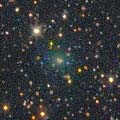
|
It reached to 13.2 mag in last spring (May 12, Carlos Labordena). But it had been unobservable for a long time after that. In the Southern Hemisphere, it is appearing in the morning sky. But in the Northern Hemisphere, it will be too low to observe.
Date(TT) R.A. (2000) Decl. Delta r Elong. m1 Best Time(A, h)
Dec. 1 13 48.80 -34 17.3 3.154 2.435 36 15.3 2:56 (301, 16)
Dec. 8 14 2.32 -36 13.4 3.165 2.491 39 15.4 2:53 (301, 19)
|
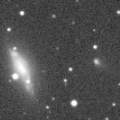
|
Now it is visible visually at 14.4 mag (Nov. 12, Alan Hale). It keeps observable in good condition until it fades out in 2008 spring.
Date(TT) R.A. (2000) Decl. Delta r Elong. m1 Best Time(A, h)
Dec. 1 1 53.70 45 48.0 1.076 1.943 140 15.4 21:14 (180, 9)
Dec. 8 1 52.93 45 31.1 1.117 1.953 136 15.5 20:49 (179, 9)
|

|
Now it is 16.5 mag (Oct. 27, Ken-ichi Kadota), brightening as expected. It will reach to 13.5 mag from March to July in 2008, and will be visible visually. It keeps observable in good condition for a long time until next May.
Date(TT) R.A. (2000) Decl. Delta r Elong. m1 Best Time(A, h)
Dec. 1 12 18.71 12 57.0 4.151 3.922 69 15.7 2:56 (249, 7)
Dec. 8 12 24.40 12 12.9 4.014 3.880 75 15.6 2:53 (246, 11)
|
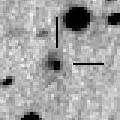
|
Now it is 16.4 mag (Oct. 3, Ken-ichi Kadota). It is expected to reach to 11 mag in 2009 summer. Because it moves in the northern sky, it keeps observable until it becomes brightest in the Northern Hemisphere.
Date(TT) R.A. (2000) Decl. Delta r Elong. m1 Best Time(A, h)
Dec. 1 5 32.19 63 23.6 5.342 6.099 136 15.7 0:57 (180, -8)
Dec. 8 5 16.94 63 52.3 5.276 6.050 138 15.6 0:14 (180, -9)
|
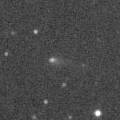
|
It brightened rapidly, and now it reached up to 14.5 mag and became visible visually (Nov. 14, Alan Hale). It will be observable in good condition for a while after this. But it will be fading rapidly.
Date(TT) R.A. (2000) Decl. Delta r Elong. m1 Best Time(A, h)
Dec. 1 2 39.61 2 26.7 1.237 2.137 147 15.8 21:59 (180, 52)
Dec. 8 2 37.73 3 11.9 1.294 2.152 141 15.9 21:30 (180, 52)
|

|
Now it is 16.6 mag (Sept. 20, Ken-ichi Kadota). Although it had been observable only in the Southern Hemisphere for a long time, now it becomes observable also in the Northern Hemisphere. It keeps 16 mag until winter.
Date(TT) R.A. (2000) Decl. Delta r Elong. m1 Best Time(A, h)
Dec. 1 3 4.51 -25 55.1 3.878 4.558 128 16.0 22:24 (180, 81)
Dec. 8 3 0.10 -24 44.1 3.937 4.571 124 16.1 21:52 (180, 80)
|
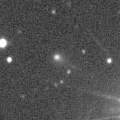
|
First return of a new periodic comet discovered in 1998 at 14 mag. It was visible visually at 14.4 mag in autumn (Oct. 6, Seiichi Yoshida). But it will be fading gradually after this.
Date(TT) R.A. (2000) Decl. Delta r Elong. m1 Best Time(A, h)
Dec. 1 23 51.27 4 29.1 2.024 2.554 111 16.1 20:41 (147, 45)
Dec. 8 23 55.36 5 9.7 2.106 2.553 105 16.2 20:49 (139, 41)
|

|
Peculiar asteroid moving on a cometary orbit. It was asteroidal at 18 mag in late August. It will reach to 15 mag in February and March. In the Northern Hemisphere, it keeps observable until July when it becomes fainter than 18 mag. It may show a cometary activity after this, although the perihelion distance is somewhat large as 1.8 A.U.
Date(TT) R.A. (2000) Decl. Delta r Elong. m1 Best Time(A, h)
Dec. 1 9 10.57 -23 36.4 1.477 1.878 97 16.6 2:56 (248, 66)
Dec. 8 9 21.14 -25 31.1 1.413 1.856 99 16.4 2:53 (248, 70)
|

|
Now it is 17.0 mag (Oct. 20, Catalina Sky Survey), brightening as expected. It keeps observable at 16.5 mag in good condition for a long time until next April.
Date(TT) R.A. (2000) Decl. Delta r Elong. m1 Best Time(A, h)
Dec. 1 11 34.65 5 47.0 2.058 2.063 76 16.5 2:56 (247, 20)
Dec. 8 11 46.24 4 58.3 1.996 2.076 80 16.5 2:53 (245, 23)
|

|
It will reach to 15 mag in 2009 and 2010. Now it is 17.3 mag (Nov. 4, J. A. Henriquez). It will be observable at 16.5 mag in good condition until winter in this year.
Date(TT) R.A. (2000) Decl. Delta r Elong. m1 Best Time(A, h)
Dec. 1 5 17.93 23 8.1 3.082 4.052 167 16.6 0:42 (180, 32)
Dec. 8 5 12.94 23 10.6 3.059 4.043 176 16.6 0:09 (180, 32)
|
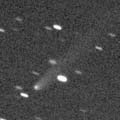
|
It was observed visually as bright as 13 mag from late 2005 to early 2006. Now it is fading. It is appearing in the morning sky again. It will be observable in good condition at 17 mag for a long time until June.
Date(TT) R.A. (2000) Decl. Delta r Elong. m1 Best Time(A, h)
Dec. 1 14 4.65 1 31.4 7.517 6.811 41 16.7 2:56 (273, -7)
Dec. 8 14 8.44 1 6.4 7.472 6.843 47 16.7 2:53 (271, -3)
|

|
Now it is 16.8 mag (Aug. 8, Ken-ichi Kadota). Before the perihelion passage, it kept 16.5-17 mag and hardly brightened. After the perihelion passage, it seems hardly to be fading.
Date(TT) R.A. (2000) Decl. Delta r Elong. m1 Best Time(A, h)
Dec. 1 0 33.77 57 28.6 3.055 3.712 125 16.7 20:41 (174, -3)
Dec. 8 0 21.83 56 28.2 3.167 3.762 120 16.8 20:49 (167, -4)
|
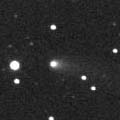
|
It reached to 13.5 mag and became visible visually in 2005 and 2006. Now it has gone far away. But the fading has been slower than predicted, and it is still bright as 16.3 mag (Nov. 7, Ken-ichi Kadota). It will be observable in good condition until February, and will keep 16-17 mag.
Date(TT) R.A. (2000) Decl. Delta r Elong. m1 Best Time(A, h)
Dec. 1 1 45.67 6 22.0 3.464 4.252 138 16.8 21:06 (180, 49)
Dec. 8 1 43.59 6 24.3 3.557 4.266 130 16.9 20:49 (175, 48)
|

|
It will reach to 15.5 mag in 2008 autumn and will be observable in good condition. In this winter, it is observable at 17 mag in good condition until March.
Date(TT) R.A. (2000) Decl. Delta r Elong. m1 Best Time(A, h)
Dec. 1 6 59.34 1 51.8 3.271 4.056 137 17.2 2:23 (180, 53)
Dec. 8 6 46.98 2 0.1 3.164 4.020 146 17.0 1:43 (180, 53)
|

|
It will be observable at 17 mag in good condition until February.
Date(TT) R.A. (2000) Decl. Delta r Elong. m1 Best Time(A, h)
Dec. 1 9 21.40 21 27.5 1.830 2.383 112 17.1 2:56 (209, 28)
Dec. 8 9 25.78 22 32.4 1.772 2.403 118 17.1 2:53 (203, 29)
|
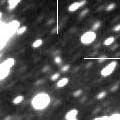
|
Now it is 17.5 mag (Sept. 16, Ken-ichi Kadota). It is outside of Jupiter's orbit. So it keeps 17 mag for a long time until winter. It keeps locating high and observable in good condition for a long time after this because it moves in the northern sky.
Date(TT) R.A. (2000) Decl. Delta r Elong. m1 Best Time(A, h)
Dec. 1 2 35.35 20 56.8 3.475 4.384 154 17.1 21:55 (180, 34)
Dec. 8 2 32.78 19 38.4 3.564 4.419 146 17.2 21:25 (180, 35)
|

|
It will reach to 13 mag in 2010. Now it is around the aphelion, but it will be observable at 17 mag in good condition in autumn and winter.
Date(TT) R.A. (2000) Decl. Delta r Elong. m1 Best Time(A, h)
Dec. 1 9 5.48 26 18.9 3.831 4.366 116 17.4 2:56 (203, 25)
Dec. 8 9 5.09 26 40.7 3.726 4.353 123 17.3 2:53 (197, 26)
|

|
It will pass 0.7 A.U. from the sun in 2008 June, and it is expected to reach to 6 mag. In the Northern Hemipshere, it keeps observable in good condition for a long time after this, while the comet is brightening gradually. The comet will be 14 mag in February and become visible visually. Then it is observable until early May, when the comet will be 7 mag. It will be unobservable for one and a half month around the perihelion passage. But it will appear in the morning sky again at 7.5 mag in late June, then it keeps observable after that while the comet is fading gradually. In the Southern Hemipsphere, it keeps observable all the period, although it will be low in late May.
Date(TT) R.A. (2000) Decl. Delta r Elong. m1 Best Time(A, h)
Dec. 1 11 56.00 -1 2.4 3.372 3.153 68 17.6 2:56 (256, 20)
Dec. 8 12 2.57 -1 57.3 3.189 3.068 74 17.4 2:53 (254, 25)
|

|
Now it is observable in good condition at 17.5 mag. But it will be fainter than 18 mag in January.
Date(TT) R.A. (2000) Decl. Delta r Elong. m1 Best Time(A, h)
Dec. 1 2 57.19 30 4.1 1.736 2.677 158 17.5 22:17 (180, 25)
Dec. 8 2 53.31 29 55.3 1.769 2.677 151 17.5 21:45 (180, 25)
|

|
It will be observable at 17.5 mag in good condition until May.
Date(TT) R.A. (2000) Decl. Delta r Elong. m1 Best Time(A, h)
Dec. 1 8 36.38 23 57.4 3.677 4.292 122 17.7 2:56 (197, 29)
Dec. 8 8 36.48 25 0.4 3.573 4.274 129 17.6 2:53 (190, 29)
|
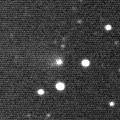
|
It was observed bright as 14-15 mag in 2004 and 2005. Now it is close to the aphelion, but it will be observable at 17.5 mag in good condition in 2007 autumn.
Date(TT) R.A. (2000) Decl. Delta r Elong. m1 Best Time(A, h)
Dec. 1 2 46.10 4 44.2 4.022 4.904 150 17.7 22:06 (180, 50)
Dec. 8 2 42.65 4 47.5 4.089 4.913 143 17.7 21:35 (180, 50)
|
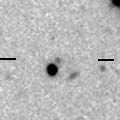
|
Now it is 17.8 mag (Nov. 18, Ken-ichi Kadota). It was observed at 17.5 mag in early 2007. It will be observable at 17.5 mag again in this winter.
Date(TT) R.A. (2000) Decl. Delta r Elong. m1 Best Time(A, h)
Dec. 1 11 8.61 -2 18.6 8.975 8.845 79 17.7 2:56 (249, 30)
Dec. 8 11 10.18 -2 19.0 8.864 8.850 85 17.7 2:53 (245, 35)
|

|
Now it is 17.5 mag (Nov. 7, Ken-ichi Kadota). Now it is at maximum of brightness, but it keeps observable in good condition for a while after this.
Date(TT) R.A. (2000) Decl. Delta r Elong. m1 Best Time(A, h)
Dec. 1 3 24.40 -5 13.3 3.209 4.087 149 17.8 22:44 (180, 60)
Dec. 8 3 20.92 -4 57.0 3.250 4.087 143 17.8 22:13 (180, 60)
|

|
It keeps 16 mag for one year from 2008 spring to 2009 spring. In the Northern Hemisphere, it keeps observable in good condition while the comet is brightening until 2008 spring. But the comet moves southwards after that, and it will never observable after 2008 July.
Date(TT) R.A. (2000) Decl. Delta r Elong. m1 Best Time(A, h)
Dec. 1 12 50.91 16 28.6 5.178 4.846 65 17.9 2:56 (251, -1)
Dec. 8 12 52.97 15 53.9 5.036 4.806 70 17.8 2:53 (248, 4)
|

|
No observations have been reported recently, but it must have already brightened up to 18 mag. It will be observable in good condition for a hile until spring. It will reach to 16.5 mag in March.
Date(TT) R.A. (2000) Decl. Delta r Elong. m1 Best Time(A, h)
Dec. 1 10 31.97 23 51.2 2.409 2.717 97 18.1 2:56 (223, 17)
Dec. 8 10 39.33 24 10.9 2.305 2.700 102 17.9 2:53 (219, 20)
|
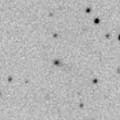
|
It was observed at 16.5-17 mag in last winter. It will be observable in good condition also in this winter. It should be 16 mag by calculation. However, it was so faint as 18.5 mag in autumn, much fainter than expected. It was observed so faint around the perihelion passage in the previous apparition at the discovery. So maybe it suddenly faded out before the perihelion passage again.
Date(TT) R.A. (2000) Decl. Delta r Elong. m1 Best Time(A, h)
Dec. 1 8 6.47 23 9.1 3.582 4.276 129 18.5 2:56 (189, 31)
Dec. 8 8 5.29 23 34.7 3.499 4.271 136 18.5 2:53 (182, 31)
|
|
![]()
 (3200) Phaethon
(3200) Phaethon 29P/Schwassmann-Wachmann 1
29P/Schwassmann-Wachmann 1 93P/Lovas 1
93P/Lovas 1 C/2006 OF2 ( Broughton )
C/2006 OF2 ( Broughton ) C/2006 S5 ( Hill )
C/2006 S5 ( Hill ) C/2006 VZ13 ( LINEAR )
C/2006 VZ13 ( LINEAR ) 110P/Hartley 3
110P/Hartley 3 P/2007 H1 ( McNaught )
P/2007 H1 ( McNaught ) C/2006 U6 ( Spacewatch )
C/2006 U6 ( Spacewatch ) C/2006 K4 ( NEAT )
C/2006 K4 ( NEAT ) C/2005 L3 ( McNaught )
C/2005 L3 ( McNaught ) C/2006 V1 ( Catalina )
C/2006 V1 ( Catalina ) 192P/2007 T3 ( Shoemaker-Levy 1 )
192P/2007 T3 ( Shoemaker-Levy 1 ) C/2006 XA1 ( LINEAR )
C/2006 XA1 ( LINEAR ) 50P/Arend
50P/Arend C/2007 B2 ( Skiff )
C/2007 B2 ( Skiff ) C/2006 W3 ( Christensen )
C/2006 W3 ( Christensen ) 191P/2007 N1 ( McNaught )
191P/2007 N1 ( McNaught ) C/2006 K1 ( McNaught )
C/2006 K1 ( McNaught ) 188P/2007 J7 ( LINEAR-Mueller )
188P/2007 J7 ( LINEAR-Mueller ) 2005 WY3
2005 WY3 70P/Kojima
70P/Kojima 74P/Smirnova-Chernykh
74P/Smirnova-Chernykh C/2003 WT42 ( LINEAR )
C/2003 WT42 ( LINEAR ) C/2006 K3 ( McNaught )
C/2006 K3 ( McNaught ) 117P/Helin-Roman-Alu 1
117P/Helin-Roman-Alu 1 C/2007 U1 ( LINEAR )
C/2007 U1 ( LINEAR ) P/2007 T6 ( Catalina )
P/2007 T6 ( Catalina ) C/2006 M1 ( LINEAR )
C/2006 M1 ( LINEAR ) 65P/Gunn
65P/Gunn C/2007 W1 ( Boattini )
C/2007 W1 ( Boattini ) P/2007 V1 ( Larson )
P/2007 V1 ( Larson ) C/2007 T5 ( Gibbs )
C/2007 T5 ( Gibbs ) P/2004 F3 ( NEAT )
P/2004 F3 ( NEAT ) C/2007 D1 ( LINEAR )
C/2007 D1 ( LINEAR ) 179P/2006 U2 ( Jedicke )
179P/2006 U2 ( Jedicke ) C/2007 M2 ( Catalina )
C/2007 M2 ( Catalina ) 180P/2006 U3 ( NEAT )
180P/2006 U3 ( NEAT ) 173P/2005 T1 ( Mueller 5 )
173P/2005 T1 ( Mueller 5 )![]()


























